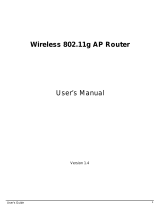
© Copyright 2012 TRENDnet. All Rights Reserved.
TRENDnet User’s Guide
Table of Contents
i
Contents
Product Overview ........................................................................... 1
Package Contents .......................................................................................................... 1
Features ......................................................................................................................... 1
Product Hardware Features........................................................................................... 2
Application Diagram ...................................................................................................... 4
Basic Router Setup .......................................................................... 5
Creating a Home Network ............................................................................................. 5
Router Installation ......................................................................................................... 6
Connect additional wired devices to your network ..................................................... 12
Wireless Networking and Security ................................................. 13
How to choose the type of security for your wireless network .................................. 13
Secure your wireless network ..................................................................................... 14
Connect wireless devices to your router ..................................................................... 17
Connect wireless devices using WPS ........................................................................... 18
Basic wireless settings ................................................................................................. 19
Steps to improve wireless connectivity ....................................................................... 21
Advanced wireless settings .......................................................................................... 22
Multiple SSID ........................................................................................................... 22
Wireless Scheduling ................................................................................................ 23
Wireless bridging using WDS (Wireless Distribution System) ................................. 24
Virtual Private Networking (VPN) .................................................. 26
Creating a Virtual Private Network .............................................................................. 26
IPsec (Internet Protocol Security) ................................................................................ 27
Site-to-Site VPN ....................................................................................................... 27
Client-Server VPN (Server Mode) ............................................................................ 31
PPTP (Point-to-Point Tunneling Protocol) ................................................................... 33
Client-Server VPN (Server Mode) ............................................................................ 33
Client-Server VPN (Client Mode) ............................................................................. 35
L2TP (Layer 2 Tunneling Protocol) ............................................................................... 38
Client-Server VPN (Server Mode) ............................................................................ 38
Client-Server VPN (Client Mode) ............................................................................. 39
GRE (Generic Routing Encapsulation)Tunneling .......................................................... 42
Access Control Filters .................................................................... 45
Access control basics ................................................................................................... 45
MAC Control ............................................................................................................ 45
URL Filters ............................................................................................................... 46
Keyword Blocking .................................................................................................... 47
Packet Outbound/Inbound Filters .......................................................................... 47
Advanced Router Setup ................................................................ 50
Access your router management page ........................................................................ 50
Change your router login password ............................................................................ 50
Set your router date and time ..................................................................................... 51
Manually configure your Internet connection ............................................................ 52
Clone a MAC address ................................................................................................... 52
Change your router IP address .................................................................................... 53
Set up the DHCP server on your router ....................................................................... 53
Set up DHCP reservation ............................................................................................. 55
Enable/disable UPnP on your router ........................................................................... 56
Allow/deny VPN connections through your router ..................................................... 57
Allow/deny multicast streaming through your router ................................................ 57
Enable/disable DoS (Denial of Service) Prevention ..................................................... 58
Allow/deny ping requests to your router from the Internet ....................................... 58




















